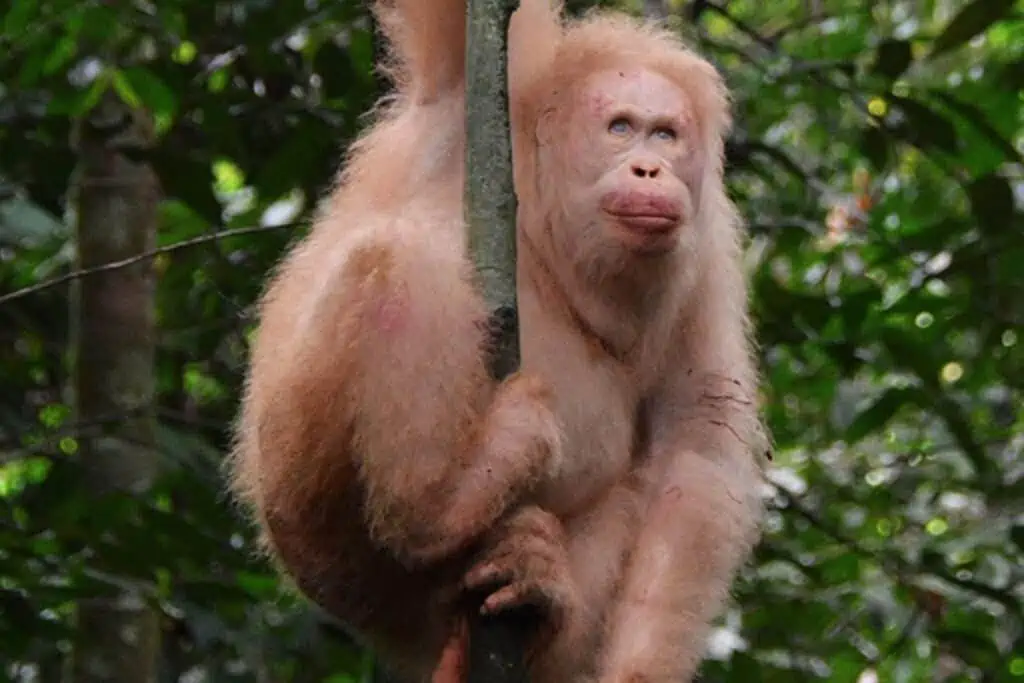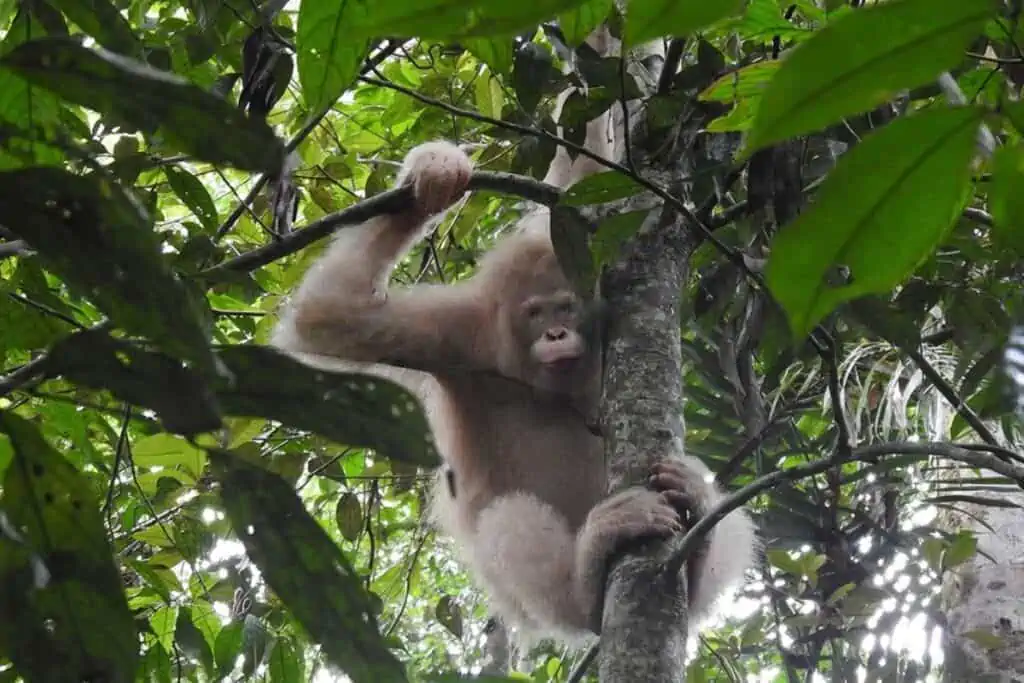Have you ever heard of the albino orangutan Alba? The Borneo Orangutan Survival Foundation volunteers say they hadn’t seen an Albino Orangutan in their 25 years of activity, making Alba a rare find.
Alba is an albino orangutan with white fur and blue eyes. Because of her albinism, she has poor eyesight and hearing ability, making her easy prey for predators. Many individuals and NGOs are working hard to keep her safe from poachers.
In this post, we’ll look at ten interesting facts about Alba, orangutan albinism, and the various dangers to her because of it.
- The albino orangutan Alba: Top 10 interesting facts
- 1. Alba is the first and only albino orangutan we know of
- 2. Alba has a melanin deficiency
- 3. Alba has weaker eyesight
- 4. Alba has poor hearing
- 5. Considerations for Alba’s skin
- 6. Alba is an easy target for predators
- 7. Alba has a much higher risk of being poached
- 8. Others warmly welcomed Alba, except for Pujon
- 9. Alba is a quick learner
- 10. Alba lives on her very own island
- Final thoughts on Alba the Albino Orangutan
- FAQs
The albino orangutan Alba: Top 10 interesting facts
As its name suggests, an albino Orangutan is the polar opposite of a melanistic orangutan. Being albino comes with challenges, as animals suffering from albinism often compromise on different aspects of their lives.
Alba is no exception – she has had to make compromises due to her genetics.
Here are some facts about this special ape related to her condition:
1. Alba is the first and only albino orangutan we know of
The BOS Foundation got a call in 2017 about an orangutan being kept as a pet in a cage in horrible conditions in a local village in Borneo.
Upon arrival at the scene, they decided to rescue the animal and discovered it was the world’s first female albino orangutan.
At five years old, this creature was named Alba through a worldwide poll.
2. Alba has a melanin deficiency
Alba’s condition is most likely albinism, characterized by a deficiency in melanin.
Usually, melanin is responsible for the coloration of an animal’s fur, skin or scales, and eyes. Without it, the affected creature usually appears bleached all over.
The most noticeable areas are the skin and eye color:
a). Skin color – a white orangutan:
Alba is an albino orangutan, meaning she has less or no melanin.
This causes her hair and skin to be white, making her the only white orangutan in the world.
Other non-albino orangutans generally have dark-colored skin (reddish-brown hair being the most common).
b). Eye color – orangutan with blue eyes:
Although popular belief dictates that animals with albinism have red eyes, this is not always the case.
For example, Alba herself has blue eyes. Most animals suffering from albinism also have blue irises, while some have hazel or brown ones.
True reddish or violet eye colors in these creatures are only an optical illusion caused by lighting conditions that allow onlookers to see the blood vessels behind their eyeballs.
3. Alba has weaker eyesight
Alba, like other albino creatures, has difficulty seeing. Examinations of Alba have revealed that she has impaired eyesight, also known as Occular Albinism (OCA).
The condition affects the retina and nerve fibers behind the eyes.
Vision issues are caused by abnormal retina development and aberrant patterns of nerve connections between the eye and brain.
The Borneo Orangutan Survival Foundation (BOSF) experimented with Alba and another orangutan in the sanctuary, where they were given food inside a plastic can with a small opening.
They had to take the food out of that tiny hole to fight their hunger.
However, the supervisor at the sanctuary noticed that some of the treats (fruits) were falling from the can, but Alba didn’t seem to notice, reflecting she had impaired vision.
4. Alba has poor hearing
Further investigation of Alba has discovered that she has an auditory problem that would complicate her survival in the rainforest.
In many animals, albinism is associated with deafness related to a deficiency of melanin.
Melanin is a pigment in several places throughout the body, including the inner ear. It is important for developing and protecting different ear parts, and disorders that cause hearing impairments are often associated with pigment abnormalities.
5. Considerations for Alba’s skin
The production of melanin, the pigment that colors skin, hair, and eyes, is affected by albinism. It’s a lifelong illness. Alba has no or little melanin, making her susceptible to light sensitivity and other skin issues such as:
a). Skin damage or allergy
Alba might have skin problems because of a lack of melanin pigment.
Because albinos cannot protect themselves from the sun’s rays, they suffer from skin damage, sunburns, and other dermatological issues.
b). Melanoma
The doctors at the BOS foundation are concerned that Alba’s chances of developing melanoma are higher because melanin typically protects the skin from UV rays.
Without it, albino creatures’ skins are more vulnerable to developing cancerous cells than other animals.
6. Alba is an easy target for predators
Being an albino orangutan, Alba is far more vulnerable in the wild since she is much easier to see due to her white color.
An animal’s coloring is often key in helping it hide from predators or prey.
She makes herself vulnerable to attackers by her inability to camouflage herself. An albino creature without this skill is almost always a sitting target.
7. Alba has a much higher risk of being poached
Although the real danger for Alba does not come from the other animals, she faces a genuine threat from people seeking to exploit her status as an extraordinary orangutan.
Experts believe that Alba may be a target for poachers on an island where hunting and habitat loss have taken the lives of over 150,000 orangutans in just 16 years—a situation that endangers not only Alba but also other animals.
Poaching is a lucrative business in a nation where about 26 million people live on less than $2 per day. According to WWF, orangutans are worth several hundred dollars in local markets, and skulls alone are valued at around $70 each.
8. Others warmly welcomed Alba, except for Pujon
Animals with albinism often suffer from isolation due to misinformation and social stigmas.
They are often perceived as being quite different from other family members or ethnic groups; therefore, they may feel alienated or be treated as if they were outsiders.
These experiences may contribute to:
- Social isolation.
- Poor self-esteem.
- Stress.
Finally, If a species is sight-oriented, albino members of the species are often seen as “outsiders” and can be killed because of it.
Fortunately, when Alba was rescued and brought to the sanctuary, she wasn’t rejected by the other orangutans because of her different appearance.
All the other orangutans at the sanctuary welcomed her with open arms, except for Pujon, who didn’t exactly extend a warm welcome when she arrived at the orphanage.
For that reason, Pujon was kept in a separate enclosure. After a week, Pujon was given a second chance and was allowed to move in with the other orangutans, and this time he was a lot more accepting of Alba’s unique appearance.
9. Alba is a quick learner
At the BOS foundation, it takes eight to ten years to teach a captive orangutan to forage for food on its own and survive alone — but Alba was found a quick learner since she had previously spent time in the forest, which allowed her to demonstrate some wild behavior.
She solved puzzles such as opening a bag’s knot in no time to receive popcorn as a reward at the sanctuary in Borneo.
Her fellow orangutans considered this same activity to be very difficult.
10. Alba lives on her very own island
To prevent Alba from being poached and sold as a one-of-a-kind Borneo Orangutan the Survival Foundation has spent $80,000 to build an artificial island in Indonesia’s huge 5-hectare (12-acre) reserve in central Kalimantan, Borneo, where she can live out the rest of her life.
The sanctuary where Alba lives with three other orangutans is surrounded by a moat and guarded by security guards 24 hours a day, seven days a week, to protect her from poachers.
Agung Nugroho, the Bukit Baka Bukit Raya National Park Authority’s head, said, “I have received reports that Alba is capable of extensive exploration, skillful foraging, and deft nest building. She also socializes with other released orangutans within the national park,”
After releasing Alba into Bukit Baka Bukit Raya National Park on 18 December 2018, the BOS foundation observed that Alba was doing well in the forest.
By the end of 2019, with the help of trackers, they found that Alba spent her time as follows:
| Time Percentage | Activity |
|---|---|
| 56.5% | Forest feeding |
| 27.2% | Traveling |
| 13.8% | Resting |
| 2.2% | Nesting and social behaviors |
Final thoughts on Alba the Albino Orangutan
Alba is an albino orangutan. She has white fur and blue eyes due to her genetic condition of albinism which also gives her poor eyesight and hearing ability.
As a result, she’s easy prey for predators. In recent years, many individuals and NGOs have stepped up their efforts to keep her safe from poachers.
Thanks to them, Alba now enjoys life on her very own island in Borneo, Indonesia.
FAQs
Is there a white orangutan?
Yes, there is a white orangutan, her name is Alba, and she is an albino orangutan. She is the only known albino orangutan in the world and therefore also the only known white orangutan in the world.
Where is Alba the orangutan?
The Borneo Orangutan Survival Foundation (BOS) released Alba into Indonesia’s Bukit Baka Bukit Raya National Park in December 2108.
The foundation reported that the female primate was doing well in her new natural habitat. She continues to reside there to this day.
Is Alba the orangutan still alive?
Yes, Alba is still alive. Since her release into the rainforest on 18 December 2018, she has been spotted multiple times in her natural habitat.
The sanctuary where she lives with three other orangutans is surrounded by a moat and constantly guarded day and night to protect her from poachers.



